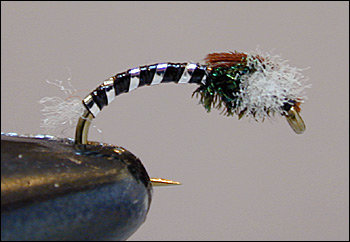
On The Fly
April 2012
"Fly tying is a school from which we never graduate"
TYING NEWS
The Southern Oregon Fly Tyers invite you to attend their meetings the second Tuesday of
each month. The next meeting is April 10, 2012. The meetings start at 6:00 PM, at the Madrone Hill
Mobile Home Park community building near Gold Hill. Bring a friend, come early so you don't miss
anything, and stay late. Tyers need not be experienced, and those with all levels of skill are
welcome. Each meeting a member is encouraged to demonstrate a new or different skill, from simple
to difficult. For more information, call Dan Kellogg at 773-4724.
DIRECTIONS: Take Gold Hill Exit #40, off of I-5 and go west, toward Jacksonville, 1.3 miles, until you
reach the brick entrance way to the Madrone Hill Mobile Home Park on the right. You’ll pass a golf course
parking lot on your left shortly after leaving the freeway. After you turn right into the
mobile home park, proceed to the community building which is located about 100 yards ahead on the left. The
address is 8401 Old Stage Rd. Please park your vehicle on the bare dirt in the parking lot to avoid the
wooden septic covers in the grass
 PATTERN OF THE MONTH -Chan's Chironomid
PATTERN OF THE MONTH -Chan's Chironomid
Hook: Daiichi 1150, Curved heavy wide gap, 16 - 22.
Thread: 8-0 black.
Tail: White poly yarn or Z-Lon
Ribbing: Fine silver tinsel or wire.
Body: Thread
Wingcase: Pheasant tail fibers.
Thorax: Peacock herl.
Head Gills: White poly yarn or Z-Lon.
Tying Instructions:
Step 1: Mash the barb and mount the hook in the vise.
Step 2: Start the thread one eye width behind the eye and lay down a smooth thread layer to a position 1/3
the way down the bend.
Step 3: Separate out a small portion of the poly yarn and tie it on top of the shank at the current thread
position. Tie the butts down along the top of the hook shank with spiral thread wraps, forward to the thread
starting position. Trim the excess.
Step 4: Tie in the ribbing at the front and secure to the top of the shank with spiral thread wraps rearward
to the base of the tail. Leave ribbing hang to the rear.
Step 5: Form a tapered body with the tying thread, ending at the thorax area.
Step 6: Wind the ribbing forward over the body in 5 evenly spaced turns to the thorax area. Tie off and
trim excess.
Step 7: Select 3-4 brown pheasant tail fibers, tie them in with the tips pointing rearward on top of the
thorax area
Step 8: Select 1 or 2 peacock herls, tie them in on top of the thorax area, and wind them forward 4-5 turns
forming the thorax. Tie off and trim excess
Step 9: Separate another small portion of the poly yarn and tie it on across the top and perpendicular to
the hook shank, just in front of the thorax. Secure with figure 8 wraps. Don't trim the excess length at
this time
Step 10: Pull the pheasant tail fibers forward over the top of the thorax and gill area an secure with firm
thread wraps and trim the excess
Step 11: Form a neat tapered head, whip finish and cement.
Chan's Chironomid is the creation of Brian Chan from Kamloops, British Columbia. Brian is
known the world over for being the Guru of Stillwater chironomid fishing and tying. Beside being a
respected author, Brian just happens to be a fisheries biologist in the wonderful trout lakes of the
Kamloops. He and Skip Morris have co-authored the excellent book, Morris & Chan on Fly Fishing Trout
Lakes.
This month fly, Chan's Chironomid, imitates the pupa stage of the "midge". emerging to
the surface to hatch. After leaving the bottom the pupa makes the sometime long slow journey to the
surface, leaving them venerable and easy pickings for hungry trout who consume them in huge quantities.
Although midges are usually associated with lake fishing, hatches are also common in many rivers but the
pupa tends to be one or two hook sizes smaller then their stillwater cousins. That unidentifiable hatch
you've experienced at dusk on your favorite river may be a midge hatch.
Tying tips:
Variations for the hundreds of different species can be as simple as varying the hook
size and the body or rib color. Common body colors are black, gray, gray olive, red, tan, or dark brown.
Some tiers claim that a red rib makes all the difference for success. You can add a bead in many color
choices for added weight. They are easy to tie, use common materials, and don't take up a lot of room. I
would always keep a small box full of size and color variations in my vest at all times.
So tie some up, give them a test flight, and let me know how you do.
Tie One On,
Dan Kellogg
(you can contact me at FLYGUY@EZNORTHWEST.COM)
www.tyerstoolshop.com